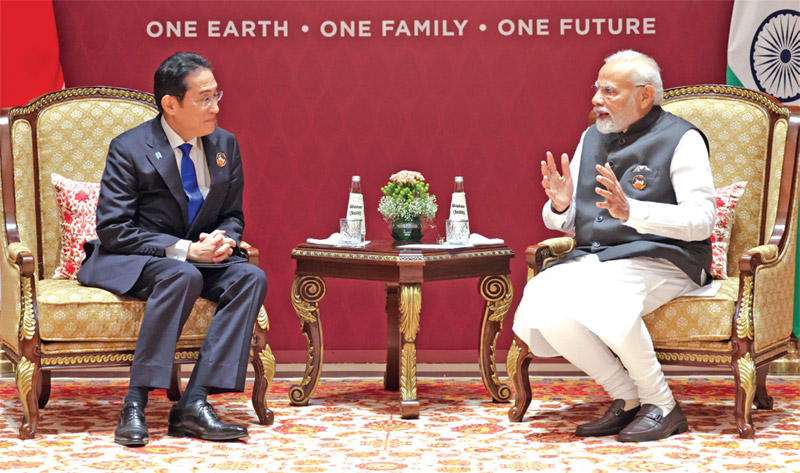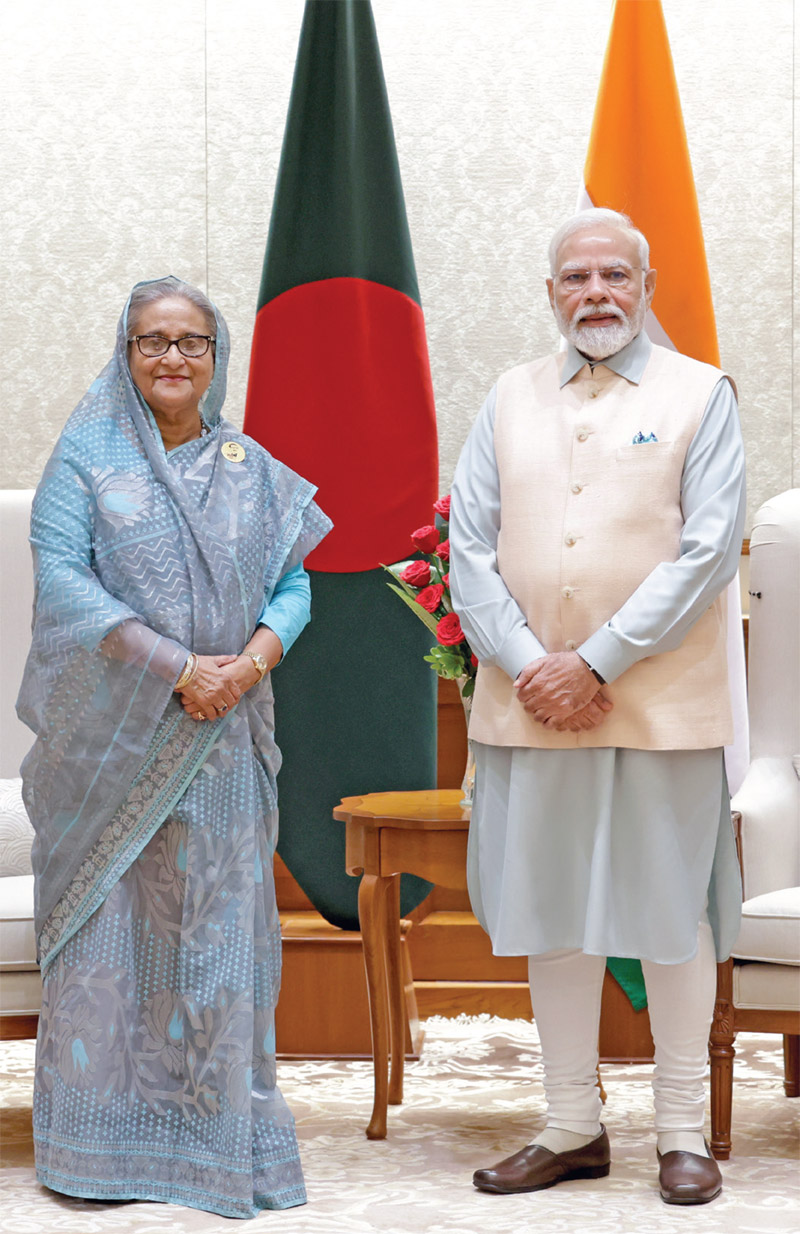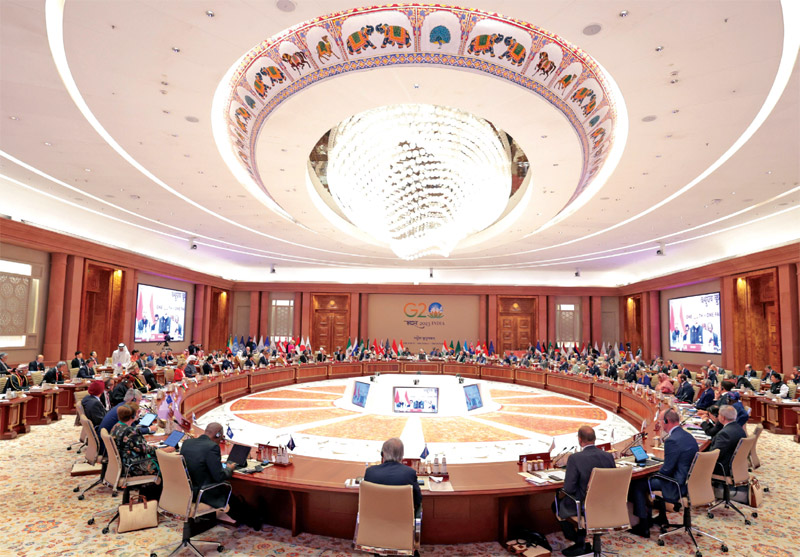With the rise of BRICS, G-20 would become increasingly irrelevant
Pravin Sawhney
By not attending Prime Minister Narendra Modi’s breakout party at G-20, Chinese President Xi Jinping has announced that the group no longer matters in geoeconomic and geopolitical terms. What matters is G-7 and its direct competitor BRICS. And if the South African edition of BRICS is the sign of the times to come, then this is where the world is converging. However, to convey China’s core message to the world that it favours globalization, it sent Premier Li Qiang to attend the G-20 summit.

Protocol could be another reason why Xi decided to miss the Delhi jamboree since Modi would have given exceptional attention to US President Joe Biden. Moreover, to communicate that bilateral ties were at an all-time low, Xi Jinping did not bother to personally convey his absence to the Indian Prime Minister.
Except for the US, all nations believe that the world is moving towards multipolarity with two overarching global visions led by the US and China respectively. Therefore, so long as they are not pushed to choose between the two visions, nations are hopeful of drawing benefits from both. What is underplayed is the reality that global prosperity ultimately hinges on the success of the fourth industrial revolution underpinned by Artificial Intelligence (AI). This software driven revolution with its competing standards, rules, norms, and regulations for the two visions will compel the nations to choose between them for digital commerce, trade, and navigation. This may happen as early as 2030. In geopolitical terms, this means that unless the US endorses globalisation in totality (trade, commerce, and especially technology, which is unlikely), early signs of bipolarity in the world fragmented between the two visions may emerge by the end of this decade.
India, which is a key geopolitical pivot in Asia Pacific (where the two visions will play out) has chosen to align with the US vision. Moreover, unwilling to adjust with the risen China, India has picked competition over cooperation with Beijing. Speaking at the Asia Society India on 13 September 2022, external affairs minister, S. Jaishankar said that a multi-polar Asia is necessary for the Asian century and multi-polar world, implying that India and China are equal poles in Asia and the world.
Jaishankar has clearly not read Zbigniew Brzezinski’s book, The Grand Chessboard, which is a fascinating treatise on global strategy. According to Brzezinski, geo-strategic players are those nations which have capability, capacity, and political will to influence events beyond their borders. The US, China, and Russia fail in this category as distinct from major powers like Germany, France, the UK, Japan and the like. Thus, all geostrategic powers are major powers, but all major powers are not geostrategic players. Interestingly, in today’s world, major powers should be assessed by their technology prowess (with the fourth industrial revolution building on the third revolution) since these influences both economic and military power.
Assessed based on technology power (AI and emerging technologies which converge into it), India is nowhere in the global game. Yet, being a significant geopolitical pivot, whose importance is derived not by its national power, but by its sensitive location, India is being sought by all three geostrategic players. Besides its geography which sits astride the 3,000 nautical miles sea lane of communication—from Strait of Hormuz to the Strait of Malacca—through which China’s four trillion dollars trade passes annually, India is also a huge market. The added attractions for the US are India’s massive, disciplined military; it being the biggest arms importer in the world; and the Modi government’s belief that a tight US embrace will help it to compete in the region with China. Before discussing why India’s strategy is a dangerous self-goal, there is need to understand the two global visions.
Two Global Visions
The US vision seeks a replay of the Cold War where containment of the Soviet sphere of influence (politically and militarily) by deterrence (military power) without a direct war between the two blocs eventually led to the USSR’s demise along with the Warsaw Pact. At the same time, the US created the Bretton Woods institutions—the World Bank and International Monetary Fund—for global economic integration. It dominated the world by its exceptional military-industrial complex, established some 760 military bases across the globe, and led the military-technical revolution (or revolution in military affairs) by ushering in the third industrial revolution pivoted on chips and internet.
In the unipolar world from 1991 to 2017, the US ruled the world based on its military and dollar dominance. It toppled governments by colour revolutions, wars, and sanctions to propagate a hegemony that sought to build a world in which its corporations and military would have full freedom. Its official ideology emphasized the importance of democracy and human rights, but these were mere expedient slogans to further Washington’s global interests.
Just as the US was fighting small wars, especially in Afghanistan and Iraq, by 2010, it realized that the People’s Liberation Army (PLA) could match the US military in the west Pacific. The PLA had operational systems and guided munitions that were as capable as its own. The PLA could close the kill chain as quickly as the US military. The PLA could conduct stand-off precision attacks at long ranges as well as the US military with its indigenous mortars, rockets, missiles, and artillery projectiles most of which were guided. Coupled with miniaturization, guided weapons brought unprecedented lethality at long ranges. This led the Pentagon to announce the third offset strategy driven by AI and autonomy in 2014.

Incidentally, China announced its One Belt One Road (or Belt and Road Initiative) project in 2013 followed by the Digital Silk Road in 2015. With expertise in destroying nations and none in building them, the US was at sea in the face of China’s numerous challenges:
- its exceptional capability and capability in international infrastructure building;
- deep pockets to fund the BRI;
- military capability in the domains of space, cyber, and electromagnetic spectrum, and land-based missiles;
- its intense integration with the world economy whereby China was the major trading partner of over 140 nations and regions;
- it being the largest global manufacturer and trader in goods. This made terms like de-coupling, de-risking, and diversifying difficult to sift through;
- its exceptional civil-military fusion for developing AI ecosystem; and
- its ability to commercialize AI incubated in the US (Silicon Valley).
Since AI is built and not bought off the shelf, China by 2017 could lead the US in three of the six stacks which comprise AI. While lagging the US in AI hardware, software, and human resources, China excelled in data management, applications (for commercialization), and integration or Internet of Things (IoT, also called internet modules). This started a tech war with the Trump administration banning Huawei 5G in 2018 and denying chips and chips-making design software and tools to China by the Biden administration.

Unable to match China’s BRI, the US started maligning it by calling it a debt trap, underplaying the fact that 138 nations from the Global South were on board. Moreover, the US with its G7 partners also dabbled in half-baked connectivity projects like Build-Back-Better-World, Global Gateway, and recently the Indian-Middle East-Europe project unveiled at the G20 summit in India. These projects, if they ever fructify, will likely supplement the BRI rather than challenge it.
Meanwhile, the Biden administration decided to double down on its own strength by turning the Obama administration’s 2011 ‘pivot to Asia’ policy into ‘integrated deterrence’ by aligning allies, strategic partners (India) and the Atlantic-specific NATO into its Indo-Pacific defence network. It was lost on the US that there is no military answer to the BRI: a strategy built on nonviolent expansion of digital commerce, trade and navigation by connectivity, AI, and big data.
If the US continues to be driven by containment and global domination, China’s speaks about ‘global respect’. Its ask that nations onboard the BRI framework (which includes the SCO and the Russia-led Eurasian Economic Union nations) remain sensitive to China’s interests while framing their foreign policy. To achieve this vision, China has enunciated its Global Development Initiative (GDI), Global Security Initiative (GSI), and Global Civilization Initiative (GCI) concepts, working under the United Nations umbrella.
Completely aligned with the UN’s Sustainable Development Goals (SDGs) for 2030, the GDI is expected to create green, efficient, and cost-effective development (given China’s lead in Lithium-ion batteries, photovoltaic or solar batteries, and new energy vehicles) through the BRI which will offer a mix of physical, mobile, and digital economies to the Global South nations. The mobile economy whose inflection point in China came in 2014 is about mobile internet, 4G networks, with consumers in the lead. This mobile economy with imported hardware was offered to the world recently by India as a highpoint of its G-20 presidency. Moreover, since China has a lead over the G7 nations in rolling out a 5G network, the inflection point for digital economy based on AI, data, cloud, and blockchain came in 2017 in China. The digital economy led by enterprises is about the industrial internet where, given China’s expertise in software, it has a leg-up in the internet module or IoT.
Fast forward to three/five years from now. The Large Language Models (LLMs) in Chat GPT-4 (Generative Pre-trained Transformer) which took the world by storm in 2023 by its generative AI will be 100s of times larger which exceptional capabilities. Instead of generating text, the new LLMs will be able to generate sequences of actions to be done and then do them by itself. Given its lead in the industrial internet on account of 5G availability at scale, China will likely focus its LLMs not on Natural Language Processing (NLP) to generate text, videos, and images like Chat GPT, but on the SDGs underpinning the GDI. For example, since the LLMs will be able to generate AI which could communicate and negotiate with humans on the phone and interact with other AIs to ensure glitches in supply chains are removed quickly, they will have tremendous usefulness in health services, smart logistics, smart cities, digital finances, biotechnology, and other applications of the fourth industrial revolution.

The LLMs will also have a big role in the creation of metaverse or the next generation of internet. The convergence of virtual reality and a digital second life (avatars) will be boosted by generative AI for business models, trade, and commerce. Thus, the technology layer underpinning the metaverse will comprise AR/VR (Augmented Reality/Virtual Reality, IoT, 5G, 6G, and mesh network which self-organize and self-configure nodes for efficiently routing data to and from clients.
From the above, two things become clear: (1) the need for cyber security against backdoor and adversarial attacks, and (2) to set standards, norms, regulations, and roles for new technologies of the fourth industrial revolution. Since the US is not willing to compete with China, but is determined to obstruct China’s innovations, the tech war started by the US will intensify. This will result in the splintering of the internet and eventually fragmentation of industrial supply chains for trade and commerce. Given this, it will become increasingly difficult for nations aligned with the two global visions to trade with one another digitally.
Furthermore, most Global South nations have been attracted by the GSI whose basic premise is indivisible security, implying no zero-sum game or one’s security at the cost of another’s security. Simply put, instead of absolute security, nations should consider relative security. The GSI also advocates an end to unilateral sanctions (outside the UN) and bloc confrontation, as well as non-interference in the internal affairs of other nations. Meanwhile, the GCI advocates respect for each nation’s traditions and values–as against the instrumentalist ‘universal values’ for human rights, democracy, and empowerment which, as we noted, the US pursues only selectively. In a fast-fragmenting world, all nations, especially big ones like India, will have to choose a side. Balancing will no longer be an option.
Thus, the contention of senior Indian analysts that India should remain engaged with BRICS, the SCO, QUAD, and the G-7 nations as this would increase its diplomatic options and help it smoothen edges in a polarized world is not sustainable.

G-20
India’s presidency of G-20 summit will be remembered for two things. One, the absence of Russian President Putin and Chinese President Xi, whose nation’s economies, according to IMF 2023 figures, grew faster than any G-7 nation. After the spectacular success of the 2013 BRICS summit in Johannesburg where the answer to US’ dollar dominance was found in BRICS Pay (this will not replace but displace SWIFT), an electronic banking system which Iran will join in January 2024 amongst other nations, means that Xi, who attended the 2022 G-20 summit in Indonesia, deliberately decided to skip the Delhi edition. Moreover, the inclusion of South African Union as the new G-20 member was a pyrrhic victory compared with the six new members added to the BRICS (including all global major energy exporters and importers) and given that 50 of the 54 African nations attended the 2023 BRICS summit. With USD 300 billion annual trade, China is the largest trading partner of the African continent where Russia is the biggest arms exporter. Thus, while China is the undisputed leader of Global South, to humour India, the US and G-7 have endorsed it as the voice of Global South.
And two, the Delhi G-20 joint declaration was made possible not because of Prime Minister Modi’s foresight or exceptional negotiating skills of the Indian diplomats as is being projected. But because India is a major geopolitical pivot wooed by the US, and not yet abandoned by China and Russia. The Delhi Declaration was a watered-down version of the Bali G-20 declaration since for the US, the bilateral Modi-Biden meeting before the official G-20 summit was far more important that the joint statement which had nothing to do with the reality of Ukraine war. Modi had one-on-one meetings with most G-7 nations since they, like the US, have stakes in the Indo Pacific region where the global geopolitics will be determined.
Given the US’ support to India’s G-20 which seems to have brightened Modi’s run at 2024 General Elections, Biden wants quick execution of the joint declaration signed during the Indian Prime Minister’s state visit to the US in June. Washington does not want India to go the Australian way, which while being a member of both QUAD and AUKUS, is now improving its trade ties with China, or like Malaysia which has decided to downplay China’s new map which infringes its sovereignty in favour of trade with China.

Modi’s Gambles
It is not understood in the US that Modi will not improve ties with China since, with the PLA sitting on Indian territory, he cannot be seen to be soft on Beijing. Winning the 2024 General Elections is his focus never mind that India is on the wrong side of geopolitics or that the Indian military is not capable of fighting a war with the PLA.
Since good geopolitics should be based on geography, India’s statecraft should concentrate on decent relations with Pakistan and China. If India was honest with itself, it would know that PLA’s April 2020 multiple incursions into Ladakh was the consequence of India creating new map (after revocation of Article 370 in Jammu and Kashmir on 5 August 2019) with Union Territory (UT) status for Ladakh. Creating a border on the map by cartographic aggression when none existed on the ground between Ladakh and Xinjiang was unacceptable to China. Conscious of this fact, and China’s displeasure, external affairs minister Jaishankar travelled to Beijing on 11 August 2019 to explain that India’s new map would not change the reality on the ground. China rejected his explanation and changed reality on the ground in Ladakh.
Sadly, the Indian military (medium power) does not have answer to PLA’s (major power) three peculiarities in the war concept that it will use against it. One, as against Indian military single physical battlespace comprising land, air, and sea war domains, the PLA will combat in four battlespaces. Its physical battlespace will comprise land, air, sea, outer space, and near space domains. The virtual battlespace will include cyberspace and the electromagnetic spectrum. The information battlespace will have wired and wireless networks through which data passes. And the cognition battlespace—where information war will be unleashed—will involve a mind war, which will entail assaulting the enemy’s judgement. The PLA will emphasize cognitive confrontation and an early cognitive defeat of the enemy.
Two, unlike the Indian military, the PLA war will not be confined to a battlefield or combat space. It will fight simultaneously in war zone (whole-of-nation with cyber, counter-space, and information war), and combat zone. And three, it will not fight a tactical war at the frontline where the Indian army has advantage, but across the entire combat at operational level where war outcome will be decided.
Given this, never before has it been more critical for India to improve relations with China. It’s not just a matter of poor military capabilities, but being on the right side of the history.

